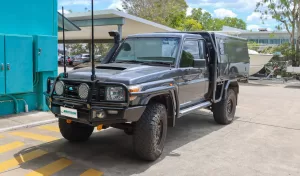Universal joints are a central piece of drivelines in equipment ranging from passenger cars to high-powered industrial processing machines. Based on simple principles, universal joints allow power to be transmitted along two unaligned shafts, vastly improving the versatility of a powertrain.
In modern vehicles with complex suspension and large ranges of motion, this versatility is a must-have feature, especially for mining equipment and light fleet 4WDs. For all their simplicity, universal joints are a critical power transmission component. To help you understand the role they play in your drivetrain, we are going to explore universal joints in more detail below.
What is a Universal Joint?
A Universal Joint (often referred to as a U-Joint or Uni Joint) is a special type of pivoting joint that allows rotational power to be transmitted between two shafts that are imperfectly aligned. Universal joints are commonly found in rear-wheel drive cars where the driven axle moves independently of the gearbox. The universal joint allows the shaft to move along with the suspension while transmitting power when there isn’t a straight line between the engine and the axle.
A universal joint consists of an X-shaped pivot point based on the design principles of gimbals. The universal joint connects two separate shafts and allows them to pivot and move independently, at relative angles of up to 45 degrees.
Typical universal joints provide two degrees of freedom, meaning the two shafts are free to rotate along two axes simultaneously (commonly the X and Y axes). In more complex applications, the universal joint may include two separate X-shaped pivots to allow the shafts to operate at much steeper angles, up to 90 degrees.
Where are Universal Joints Used?
Universal joints predate modern engineering by centuries. For as long as humans have been producing power – such as through wind or water mills – universal joints have been used to transmit power.
These days, universal joints are found in some of the world’s most common machinery types, including:
- Vehicles. Universal joints are commonly found in the prop shaft of rear-wheel and four-wheel drive cars. The prop shaft runs from the gearbox at the front of passenger vehicles back to the rear axle. Placing a universal joint at either end of the shaft allows power to be transmitted without bending or snapping the shaft as the rear axle moves on its suspension.
- Marine. Passenger vehicles and trucks aren’t the only vehicles that use prop shafts. Boats and other marine craft commonly use propeller shafts to transfer power from the engine to the propeller where the two components are out of plane.
- Machinery. Mining, manufacturing, agriculture and a wide variety of materials handling technologies all require universal joints to transfer power from their motors to the final consumer. Universal joints designed for machinery and manufacturing applications are typically far more robust than those used in vehicles and are often expected to stand up to harder use and higher-powered equipment.
Signs of a Failing Universal Joint
Universal joints are a critical component in the drivetrain of all types of vehicles and other equipment. Over time the bushes and centre bearings in the joint will be worn down through repeated use, requiring the joint to be replaced.
There are a few common signs that a universal joint is about to fail or needs to be replaced:
- Excess vibrations when accelerating and decelerating
- Clunking noises when changing gears
- Loud banging or clanking during normal use
A broken universal joint won’t just prevent your vehicle from moving. If it fails while driving, the broken joint can cause serious damage to the prop shaft, the underside of your car and other driveline components.
It’s important to regularly inspect universal joints as part of your vehicle’s maintenance schedule, especially if the vehicle is regularly used in dusty, sandy or salty environments that can accelerate the joint’s wear and tear.
Need Drivetrain Maintenance and Servicing? Speak to Driveline Services Today!
Universal joints are a critical component in the drivetrains of thousands of vehicles, boats and other equipment. To avoid causing any unnecessary damage, universal joints should regularly be inspected and serviced by an experienced technician.
The team at Driveline are Australia’s underbody and power transmission specialists! We work with everything from 4WDs and passenger vehicles to heavy trucks, mining machinery and industrial equipment.
We produce and import more than 20,000 high-quality parts, including universal joints that can keep your machinery turning and your fleet on the road. Speak to us today to arrange drivetrain and underbody servicing by the experienced Driveline team!


